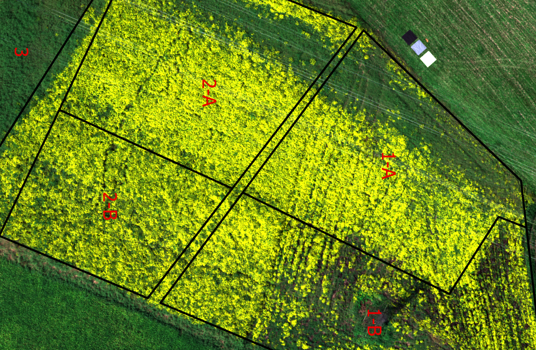Overview
Objective
Utilities manage rights-of-way (ROWs) with the goal of providing safe and reliable delivery of electricity. ROW managers actively control vegetation in ROWs through tree trimming activities and integrated vegetation management (IVM) practices that promote low-growing vegetation, which, in turn, inhibits growth of tall trees.
The objective of this research is to identify and evaluate opportunities to reduce vegetation management (VM) costs while maintaining high reliability and enhancing environmental compatibility. These outcomes are achieved by evaluating different technologies for monitoring and assessing vegetation management needs and IVM practices, including remote sensing technologies. Technologies are often tested in small plots or demonstrations within utility ROWs so members can make informed decisions prior to large scale deployments.
Approach

Integrated Vegetation Management (IVM) Practices:
IVM practices promote the use of low-growing, native vegetation in ROWs. These native plants reduce costs and help restore habitats for indigenous species and pollinators, helping utilities to accomplish good environmental stewardship and meet corporate goals. This task examines different IVM methods, field-tests new vegetation management products, and investigates the use of ROWs to promote native plant and animal species.

Optimized Vegetation Management Techniques:
New technologies can help optimize trimming cycles by identifying canopy height, encroachment, hazard trees, etc. They may also help with species identification, estimation of growth rates, and tree health assessment. New technologies may also help utilities with the execution and workflow of their vegetation management activities. This task examines the performance of current and emergent technologies aimed at optimizing vegetation management activities.

Remote Sensing:
Remote sensing technologies can have alternative uses in vegetation management, particularly in monitoring the biodiversity of ROWs. This task studies applications and benefits of remote sensing technologies to achieve corporate goals.
Research value
- Reduces vegetation management costs through new technologies and approaches
- Decreases the frequency of vegetation-caused T&D outages
- Develops a more ecologically diverse plant com- munity capable of outcompeting undesirable plant species along T&D ROWs
- Evaluates the usefulness of new vegetation monitoring technologies in optimizing trimming cycles
- Provides data to inform compliance with the North American Electric Reliability Corporation’s (NERC’s) mandatory vegetation management standards
- Facilitates the achievement of corporate environmental stewardship and ROW goals and help change public perception of the value of T&D ROWs
Research plans
Current long-term projects
Assessing ROW Habitat for Bees, Birds, and Bats Compared to Other Land Cover Types
Rights-of-way (ROWs) may provide critical conservation habitat to a variety of species. This research will assess the conservation value of ROW habitat compared to other land cover types by comparing 5 different common land cover classes: ROW, Ag, urban, forest, and prairie conservation habitat. ROWs under evaluation will be paired with one of the off-ROW habitat cover classes with vegetation data, visual pollinator counts, bird point counts, and acoustic data for bats and birds being collected.
Project span: 2025-2027
Do ROWs Support Bats Through Increased Forage Resources?
Many species such as bats depend on insects as a food resource. ROWs may play an important role in bat dispersal connecting overwintering and summer roosting sites as well as provide critical foraging grounds for bats This project would use passive and active monitoring techniques to document the value of ROWs to bats on ROWs under different vegetation management strategies.
Project span: 2023-2026
Can eDNA be Used to Detect Pollinators?
EPRI currently supports a variety of research evaluating habitat establishment and vegetation management practices for pollinators. Utility companies are interested in rapid assessments of pollinator communities to determine how different management strategies are impacting groups like native bees and butterflies. A proof-of-concept study is being conducted to evaluate the feasibility of using eDNA to detect and identify pollinators present on a suite of native flowering forb species.
Project span: 2023-2025
2025 Projects
ROW Pests: Monitoring, Management, & Movement
Invasive species (plants, insects, and pathogens) can create management issues on ROWs. Tracking new invasive species, identifying management strategies, and predicting if species will impact your service territory is challenging. This project will create a guide of the most problematic and recently detected invasive species for different regions of North America.
Success Stories - Integrated Vegetation Management Value and Biodiversity Initiatives
Utilizing IVM leading practices in vegetation management plays a crucial role in increasing stewardship and conservation efforts while maintaining safety and reliability. Through implementing IVM, vegetation management activities become more targeted, efficient, and environmentally responsible, resulting in enhanced environmental benefits. Communicating the value of IVM programs to internal and external stakeholders is challenging. The benefits of IVM in terms of reliability, stewardship, and conservation will be shared by creating deliverables to engage and educate company colleagues as well as the public.
Coated Native Seeds: Field Installation Methods and Establishment
The establishment of native seed mixes can be a valuable tool in managing vegetation on utility lands. Utility companies are continually exploring new seeding strategies that will lower costs while increasing establishment success. Recent advances in seed coating, which standardize seeds in size and shape through the addition of external materials, can make native seeds compatible with traditional farming equipment such as grain planters and seed drills. The coated native seed may also improve seed distribution through broadcast seeders improving stand evenness once established. Coated native seeds have the potential to eliminate the need for specialized equipment, and make installing native seed mixes more efficient, accessible, and cost effective.
Taking Flight: How Drones are Changing ROW Management
Drones are increasingly being leveraged in right-of-way management for inspections of utility infrastructure and vegetation. However, another possible use of drone technology is the application of herbicides to control woody species. Drones have the potential to improve personnel safety by performing necessary vegetation management in difficult to access terrain. EPRI in collaboration with AEP, the Dawes Arboretum, and The Davey Tree Expert Company conducted a drone spot spray demonstration to evaluate the effectiveness of using drones to control woody tree sprouts while protecting surrounding non-target vegetation.